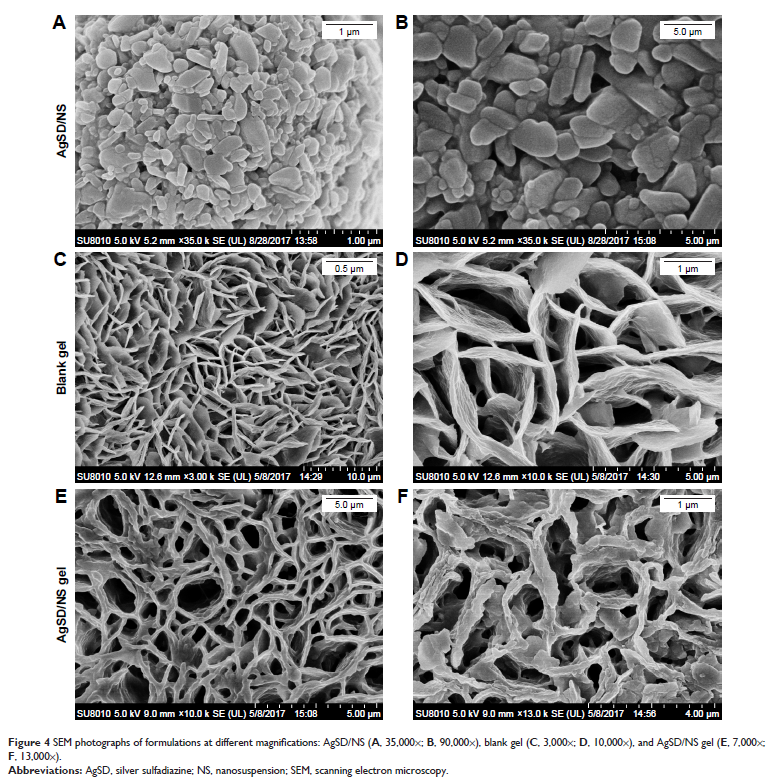9 0 6 7 6
论文已发表
注册即可获取德孚的最新动态
IF 收录期刊
- 2.6 Breast Cancer (Dove Med Press)
- 3.9 Clin Epidemiol
- 3.3 Cancer Manag Res
- 3.9 Infect Drug Resist
- 3.6 Clin Interv Aging
- 4.8 Drug Des Dev Ther
- 2.8 Int J Chronic Obstr
- 8.0 Int J Nanomed
- 2.3 Int J Women's Health
- 3.2 Neuropsych Dis Treat
- 4.0 OncoTargets Ther
- 2.2 Patient Prefer Adher
- 2.8 Ther Clin Risk Manag
- 2.7 J Pain Res
- 3.3 Diabet Metab Synd Ob
- 4.3 Psychol Res Behav Ma
- 3.4 Nat Sci Sleep
- 1.9 Pharmgenomics Pers Med
- 3.5 Risk Manag Healthc Policy
- 4.5 J Inflamm Res
- 2.3 Int J Gen Med
- 4.1 J Hepatocell Carcinoma
- 3.2 J Asthma Allergy
- 2.3 Clin Cosmet Investig Dermatol
- 3.3 J Multidiscip Healthc

负载磺胺嘧啶银纳米悬浮液的热敏水凝胶作为局部抗菌剂
Authors Liu X, Gan H, Hu C, Sun W, Zhu X, Meng Z, Gu R, Wu Z, Dou G
Received 18 September 2018
Accepted for publication 1 December 2018
Published 28 December 2018 Volume 2019:14 Pages 289—300
DOI https://doi.org/10.2147/IJN.S187918
Checked for plagiarism Yes
Review by Single-blind
Peer reviewers approved by Dr Cristina Weinberg
Peer reviewer comments 2
Editor who approved publication: Dr Mian Wang
Background: Silver sulfadiazine (AgSD) is widely
employed as an antibacterial agent for surface burn management. However, the
antibacterial activity of AgSD was restrained because of the lower drug
solubility and possible cytotoxicity.
Objective: This
study aimed to formulate stable silver sulfadiazine/nanosuspensions (AgSD/NSs)
with improved AgSD solubility and prepare a suitable carrier for AgSD/NS
delivery. Nanotechnology was used to overcome the low drug dissolution rate of
AgSD, while the new carrier loaded with AgSD/NS was assumed to decrease the
possible cytotoxicity, enhance antibacterial activity, and promote wound
healing.
Methods: AgSD/NSs
were prepared by high pressure homogenization method. Poloxamer 407-based
thermoresponsive hydrogels were prepared by cold method as carriers of AgSD/NS
to obtain AgSD/NS-loaded thermoresponsive hydrogel. Scanning electron
microscope (SEM), Fourier transform infrared spectroscopy (FTIR) and X-ray
diffraction (XRD) were used to measure the physicalchemical properties of
AgSD/NSs and AgSD/NS-loaded gel. The cytotoxicity of the AgSD/NS-loaded gel was
evaluated using methyl thiazolyltetrazolium assay with L929 mouse fibroblast
cell lines. In vitro antibacterial activities of AgSD/NSs and AgSD/NS loaded
gel were also measured.
Results: Stable
AgSD/NSs with an average particle size of 369 nm were formulated while 1.5%
P407 was selected as a stabilizer. The optimized AgSD/NS thermoresponsive
hydrogel exhibited the gelation temperature of approximately 30°C. A
significant improvement in solubility was observed for AgSD nanoparticles
(96.7%) compared with AgSD coarse powders (12.5%). The results of FTIR and XRD
revealed that the physicochemical properties of AgSD/NS were reserved after
incorporating into the hydrogel. The cell viability after incubation with
AgSD/NS-loaded thermoresponsive hydrogel improved from 60.7% to 90.6% compared
with incubation with AgSD/NS directly. Drug release profiles from the
thermoresponsive hydrogel increased compared with the commercial AgSD cream,
implying less application frequency of AgSD cream clinically. In vitro
antibacterial studies manifested that AgSD nanocrystallization significantly
enhanced the antibacterial activity compared with the AgSD coarse powder.
Conclusion: The
combination of AgSD nanosuspensions and thermoresponsive hydrogel effectively
improved the AgSD antibacterial activity and decreased the cytotoxicity. This
study also suggested that a poloxamer thermoresponsive hydrogel could be used
as a delivery system for other nanocrystals to decrease possible nanotoxicity.
Keywords: cytotoxicity,
wound healing infection, nanotechnology
